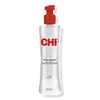What's inside
What's inside
 Key Ingredients
Key Ingredients

 Benefits
Benefits

 Concerns
Concerns

 Ingredients Side-by-side
Ingredients Side-by-side

Water
Skin ConditioningDimethicone
EmollientCyclotetrasiloxane
EmollientGlycerin
HumectantPolysilicone-15
UV FilterPolysilicone-19
Parfum
MaskingHydrolyzed Silk
HumectantTocopheryl Acetate
AntioxidantSymphytum Officinale Leaf Extract
Skin ConditioningAnthemis Nobilis Flower Extract
MaskingMentha Piperita Leaf Extract
Skin ConditioningLavandula Angustifolia Extract
Skin ConditioningSalvia Sclarea Extract
AntiseborrhoeicDimethiconol
EmollientAmodimethicone
Cetrimonium Chloride
AntimicrobialTrideceth-8
EmulsifyingCyclopentasiloxane
EmollientPanthenyl Hydroxypropyl Steardimonium Chloride
Sodium Polyacrylate
AbsorbentTrideceth-6
EmulsifyingPEG/PPG-18/18 Dimethicone
EmulsifyingPhenoxyethanol
PreservativeMethylisothiazolinone
PreservativeLinalool
PerfumingCoumarin
PerfumingLimonene
PerfumingWater, Dimethicone, Cyclotetrasiloxane, Glycerin, Polysilicone-15, Polysilicone-19, Parfum, Hydrolyzed Silk, Tocopheryl Acetate, Symphytum Officinale Leaf Extract, Anthemis Nobilis Flower Extract, Mentha Piperita Leaf Extract, Lavandula Angustifolia Extract, Salvia Sclarea Extract, Dimethiconol, Amodimethicone, Cetrimonium Chloride, Trideceth-8, Cyclopentasiloxane, Panthenyl Hydroxypropyl Steardimonium Chloride, Sodium Polyacrylate, Trideceth-6, PEG/PPG-18/18 Dimethicone, Phenoxyethanol, Methylisothiazolinone, Linalool, Coumarin, Limonene
Ingredients Explained
These ingredients are found in both products.
Ingredients higher up in an ingredient list are typically present in a larger amount.
This water-soluble silicone is used for its hydrating and softening properties. It is used to add a silky feel to skincare products and has great benefits for haircare.
In haircare, this ingredient:
- Adds shine
- Protects color
- Offers thermal protection
- Boosts hair strength
- Does not build up as easily
Cyclopentasiloxane, or D5, is a silicone used to improve texture of products and trap moisture.
D5 is considered lightweight and volatile. Volatile means it evaporates quickly after application. Once evaporated, D5 leaves a thin barrier that helps keep skin hydrated.
It is also an emollient. Emollients help soften the skin and prevent water loss. Silicones create a silky texture in products. D5 helps other ingredients become more spreadable.
Studies show D5 is safe to use in skincare products. We recommend speaking with a skincare professional if you have concerns.
Learn more about CyclopentasiloxaneDimethicone is a type of synthetic silicone created from natural materials such as quartz.
What it does:
Dimethicone comes in different viscosities:
Depending on the viscosity, dimethicone has different properties.
Ingredients lists don't always show which type is used, so we recommend reaching out to the brand if you have questions about the viscosity.
This ingredient is unlikely to cause irritation because it does not get absorbed into skin. However, people with silicone allergies should be careful about using this ingredient.
Note: Dimethicone may contribute to pilling. This is because it is not oil or water soluble, so pilling may occur when layered with products. When mixed with heavy oils in a formula, the outcome is also quite greasy.
Learn more about DimethiconeDimethiconol is a silicone that resembles the popular dimethicone. Like other silicones, it is an emollient. Emollients create a thin film on skin to prevent moisture from escaping.
This ingredient helps to create a silky texture and improve spreadability. Due to its high molecular weight and thickness, it is often combined with cyclopentasiloxane.
Parfum is a catch-all term for an ingredient or more that is used to give a scent to products.
Also called "fragrance", this ingredient can be a blend of hundreds of chemicals or plant oils. This means every product with "fragrance" or "parfum" in the ingredients list is a different mixture.
For instance, Habanolide is a proprietary trade name for a specific aroma chemical. When used as a fragrance ingredient in cosmetics, most aroma chemicals fall under the broad labeling category of “FRAGRANCE” or “PARFUM” according to EU and US regulations.
The term 'parfum' or 'fragrance' is not regulated in many countries. In many cases, it is up to the brand to define this term.
For instance, many brands choose to label themselves as "fragrance-free" because they are not using synthetic fragrances. However, their products may still contain ingredients such as essential oils that are considered a fragrance by INCI standards.
One example is Calendula flower extract. Calendula is an essential oil that still imparts a scent or 'fragrance'.
Depending on the blend, the ingredients in the mixture can cause allergies and sensitivities on the skin. Some ingredients that are known EU allergens include linalool and citronellol.
Parfum can also be used to mask or cover an unpleasant scent.
The bottom line is: not all fragrances/parfum/ingredients are created equally. If you are worried about fragrances, we recommend taking a closer look at an ingredient. And of course, we always recommend speaking with a professional.
Learn more about ParfumTocopheryl Acetate is AKA Vitamin E. It is an antioxidant and protects your skin from free radicals. Free radicals damage the skin by breaking down collagen.
One study found using Tocopheryl Acetate with Vitamin C decreased the number of sunburned cells.
Tocopheryl Acetate is commonly found in both skincare and dietary supplements.
Learn more about Tocopheryl Acetate